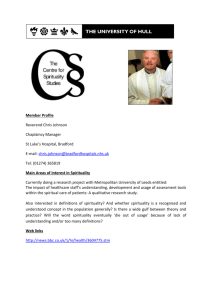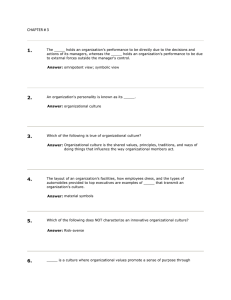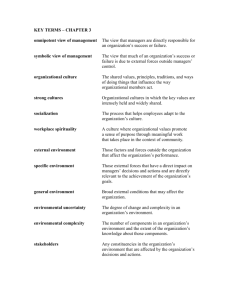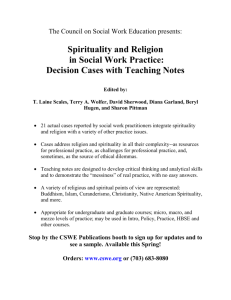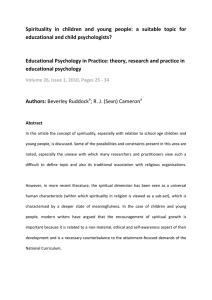Proceedings of 7th Annual American Business Research Conference
advertisement
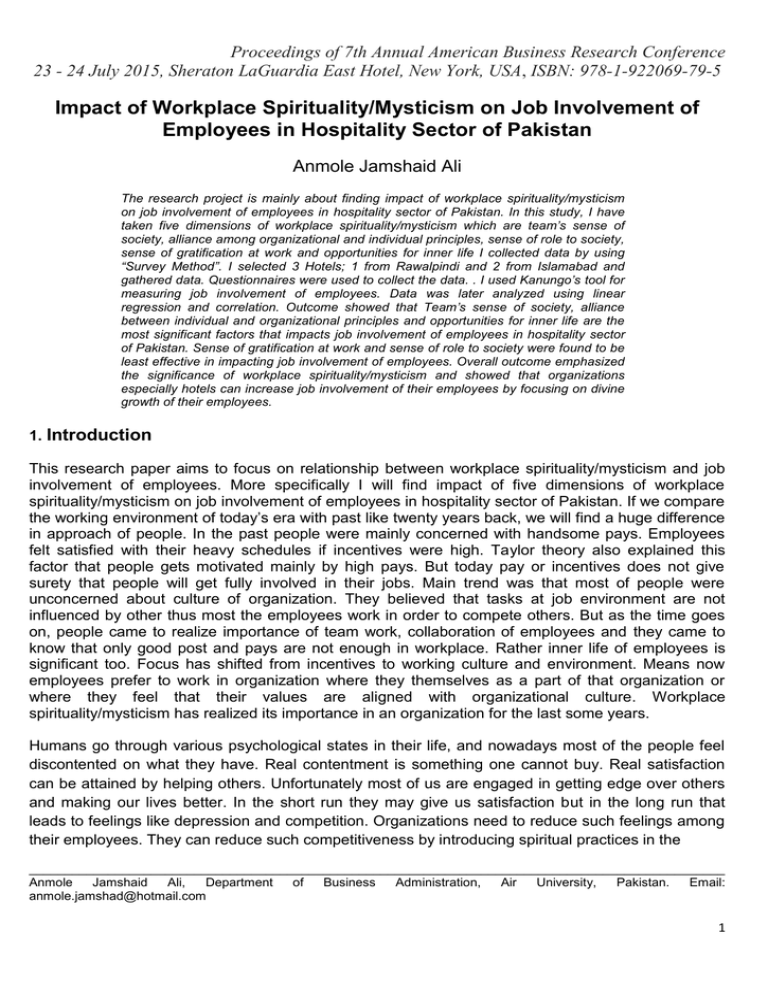
Proceedings of 7th Annual American Business Research Conference 23 - 24 July 2015, Sheraton LaGuardia East Hotel, New York, USA, ISBN: 978-1-922069-79-5 Impact of Workplace Spirituality/Mysticism on Job Involvement of Employees in Hospitality Sector of Pakistan Anmole Jamshaid Ali The research project is mainly about finding impact of workplace spirituality/mysticism on job involvement of employees in hospitality sector of Pakistan. In this study, I have taken five dimensions of workplace spirituality/mysticism which are team’s sense of society, alliance among organizational and individual principles, sense of role to society, sense of gratification at work and opportunities for inner life I collected data by using “Survey Method”. I selected 3 Hotels; 1 from Rawalpindi and 2 from Islamabad and gathered data. Questionnaires were used to collect the data. . I used Kanungo’s tool for measuring job involvement of employees. Data was later analyzed using linear regression and correlation. Outcome showed that Team’s sense of society, alliance between individual and organizational principles and opportunities for inner life are the most significant factors that impacts job involvement of employees in hospitality sector of Pakistan. Sense of gratification at work and sense of role to society were found to be least effective in impacting job involvement of employees. Overall outcome emphasized the significance of workplace spirituality/mysticism and showed that organizations especially hotels can increase job involvement of their employees by focusing on divine growth of their employees. 1. Introduction This research paper aims to focus on relationship between workplace spirituality/mysticism and job involvement of employees. More specifically I will find impact of five dimensions of workplace spirituality/mysticism on job involvement of employees in hospitality sector of Pakistan. If we compare the working environment of today‟s era with past like twenty years back, we will find a huge difference in approach of people. In the past people were mainly concerned with handsome pays. Employees felt satisfied with their heavy schedules if incentives were high. Taylor theory also explained this factor that people gets motivated mainly by high pays. But today pay or incentives does not give surety that people will get fully involved in their jobs. Main trend was that most of people were unconcerned about culture of organization. They believed that tasks at job environment are not influenced by other thus most the employees work in order to compete others. But as the time goes on, people came to realize importance of team work, collaboration of employees and they came to know that only good post and pays are not enough in workplace. Rather inner life of employees is significant too. Focus has shifted from incentives to working culture and environment. Means now employees prefer to work in organization where they themselves as a part of that organization or where they feel that their values are aligned with organizational culture. Workplace spirituality/mysticism has realized its importance in an organization for the last some years. Humans go through various psychological states in their life, and nowadays most of the people feel discontented on what they have. Real contentment is something one cannot buy. Real satisfaction can be attained by helping others. Unfortunately most of us are engaged in getting edge over others and making our lives better. In the short run they may give us satisfaction but in the long run that leads to feelings like depression and competition. Organizations need to reduce such feelings among their employees. They can reduce such competitiveness by introducing spiritual practices in the _________________________________________________________________________________________________ Anmole Jamshaid Ali, Department of Business Administration, Air University, Pakistan. Email: anmole.jamshad@hotmail.com 1 Proceedings of 7th Annual American Business Research Conference 23 - 24 July 2015, Sheraton LaGuardia East Hotel, New York, USA, ISBN: 978-1-922069-79-5 workplace so that employees move beyond self-centered approach. If organizations focus on introducing such practices, employees would have opportunity to grow themselves from inside too and those practices will make them think in a broader way. Secondly those practices may leads to such bonding between employees that they prefer to work in collaboration with each other rather than competition. Second factor is that most of the organizations now realize that employees can work effectively in flat structured environment . Researches indicate that organizations that create such an environment where employees have certain degree of freedom and they are empowered relate themselves better to the workplace (Catlette and Hadden; 1998, Channon; 1992, Hawley; 1993, Catlette and Hadden; 1998). Spirituality/mysticism was found to be negatively related to stress at work (Atkins; 2007), depression (Robertson; 2007 and Yoshioka; 2007). Landis found a relationship between spirituality/mysticism and psychosocial adjustment. In the study of Markow and Klenke (2005), organizational commitment was found to be positively related with personal meaning profile and work as calling but negatively associated to intention to quit. Organizational spirituality/mysticism with job satisfaction was found to be positively related (Van der Walt; 2007). In relating spirituality/mysticism with performance indicators, McGeachy (2001) posited that personal fulfillment led to outstanding performance which resulted into organizational financial success. As regards academic performance, the role of spirituality/mysticism was confirmed in improving academic performance of college and university students (Reyes; 2006 and Bohr; 2007). Although many researchers have come up with concept of spirituality/mysticism in their researches but this paper aims to focus on observing impact of workplace spirituality/mysticism on job involvement of employees particularly while studies in the past were focusing mainly on its impact on organizational commitment and satisfaction. So this research will fill that gap by introducing a new variable Research Question “To find impact of five dimensions of Workplace Spirituality/mysticism that are Team’s sense of society, Alliance between individual and organizational principles, Sense of gratification at work, Sense of role to society and Opportunities for inner life on job involvement of employees in hospitality sector of Pakistan.” 2. Literature Review Workplace spirituality/mysticism Lot of research has been done in the past regarding workplace spirituality/mysticism. However different authors come up with their own definitions and explanations. Spirituality/mysticism has been defined by authors in various ways in the past. Legere says that spirituality is an effort to understand meaning of life. Spirituality was defined by Conger and Associated as experience of going beyond self-interest. Ashmos and Duchon define it as living a meaningful life in context of community. McClain and BreitBart defined it as understanding ultimate values of life. Marques defined it as feeling 2 Proceedings of 7th Annual American Business Research Conference 23 - 24 July 2015, Sheraton LaGuardia East Hotel, New York, USA, ISBN: 978-1-922069-79-5 of trust and interconnected between employees through goodwill which leads to their enhanced performance. When an organization understands about importance of their inner life and growth of inner life, it depends upon how well they deal with other members of society that refers to workplace spirituality (Ashmos and Duchon; 2000). Other definition of workplace spirituality/mysticism is that when organization provides employees with such an environment that they feel sense of completion and happiness in their life and feel themselves as a part of that community (Giacalone and Jurkiewics; 2003). Mitroff explained concept of workplace spirituality/mysticism as the situation when employees make every effort to find real purpose of their life (Cavanagh; 1999). Spirituality/mysticism is a need of every individual and we cannot negate importance of this in our lives (Hart and Brady 2005). When people perceive that their workplace is supporting them in terms of satisfying their spiritual needs, they will be more devoted to organization (Armenio Rego; 2007) It is important to understand that for some people spirituality/mysticism at work involves a religious meaning while for others it does not (Neck and Milliman; 1994). One of the contradictions in this concept is that many authors consider spirituality/mysticism as connected to religion of an individual. However some others explained it as concept beyond boundaries of religion. Labbs explained it as something that is very flexible and that cannot be imposed on any individual and thus he doesn‟t feel any association between workplace spirituality/mysticism and religion (1995). One author explained it as something that is based on standards and philosophies of an individual and that may not be necessarily linked to religion and it‟s a much broader concept regardless of any boundaries (Mitroff and Denton; 1999). Although there may be some characteristics common between religion and spirituality/mysticism however religion contains an additional dimension of theological structure that is restrictive, while spirituality/mysticism cannot be restrictive (Davis Kerr and Kurpius; 2003). Human beings are rational, but also emotional and spiritual. They have a mind, but also Spiritual needs and that spiritual development are essential for their mental development (Ashmos and Duchon; 2000, p. 136). Pava (2003) argued that all human activities are spiritual to some extent. Organizations that don‟t realize importance of spirituality/mysticism for their employees are usually unsuccessfully in satisfying their employees. Each individual has his different experience of spirituality/mysticism and all of them nourish it differently. If an organization allows their employees to satisfy their spiritual needs in that workplace, it is highly possible that employees will bring their heart, mind and soul to that job thus resulting in individual and organizational benefits. (Armenio Rego). Garcia-Zamor (2003) put emphasis on bringing spirituality/mysticism into the workplace to create a different organizational culture in which the employee would be more satisfied and would have an improved performance. Also, he remarked, “in a more humanistic environment, employees are more creative and have higher morale” (p. 362). Some authors claim that spiritual growth is important due to the fact that work has become increasingly important in employees‟ life nowadays (Conger; 1994; Burroughs and Eby; 1998; Jurkiewicz and Giacalone; 2004). Workplace spirituality/mysticism is kind of remedy for the “ills of modern management” (Brown; 2003, p. 396) and a way to enhance the trust between employer and employee, that have been lost due to practices that go along with the huge processes of downsizing, the abuses of workers and other actions that get through psychological contracts (Jurkiewicz and Giacalone; 2004). Some authors claim that spirituality/mysticism contributes to organizational better performance (Milliman et al; 1999; Benefiel; 2003b; Giacalone and Jurkiewicz, 2003; Sanders III et al., 2003; Garcia-Zamor; 2003; Jurkiewicz and Giacalone; 2004). 3 Proceedings of 7th Annual American Business Research Conference 23 - 24 July 2015, Sheraton LaGuardia East Hotel, New York, USA, ISBN: 978-1-922069-79-5 Job involvement Job involvement is an inner belief of a person where he identifies himself with the job (Kunango; 1982). Employees that are fully involved in their jobs better relate themselves with the job. Past results show that highly involved employees are more likely to stay with their organization for the long time than others (Kahn, 1990; Kanungo, 1979; Lawler, 1986; Pfeffer, 1994). Job involvement has a direct link with motivation of employees (Bashow and Grant; 1994). Conversely low involved employees are more likely to leave organization early and engage in various unnecessary activities (Kanungo; 1979, p. 133). When an individual feel that his values are aligned with his workplace, he gets more involved in job (Ramsay; 1995). Job involvement is an employee‟s belief about how much his job gratifies his needs makes them motivated for work. (Hackett; 2001). High job involvement of an employee leads towards his significant contribution to company goals and self-determination (Ramsay 1995, Blau and Boal; 1987). One of the most important requisite for involving employees in their jobs is by recognizing their needs (Kanungo; 1982). Consistent with this Brown also suggests that by fulfilling needs of employees, they get involved in their jobs more (1996). One of the definitions of job involvement is the degree to which an individual is concerned with and engaged in his current job. (Paulley; 1994).when an employee put effort towards achievement of his self-respect, prestige and self-esteem, that leads to job involvement (Allport; 1943This study adopts Kanungo definition of job involvement as the cognitive state of an individual‟s psychological identification with the job (Igbaria et al; 1994). Individuals with high levels of both job involvement are the most motivated to go to. Individuals with low levels of job involvement should be the least motivated. Both highly motivated and non-motivated employees may miss their work for many reasons. (e.g., illness, ritual holidays, vacation time, and transportation problems). However, highly motivated employees do not miss work or come late for lame reasons. Individuals with higher levels of job involvement and organizational commitment are likely to exhibit less excuses as compared to individuals with lower levels of job involvement and organizational commitment (Blau; 1986 and Blau & Boal; 1987). Most of the theorists hypothesized that highly involved employees in jobs are less likely to quit their jobs as compared to less involved employees (Kahn 1990; Kanungo 1979; Lawler; 1986). More involved employees feel more competent and successful at work, because they believe that their personal and organizational goals are aligned, and tend to attribute positive work outcomes to their internal and personally controllable factors (Chi Shun Liou; 2009). Job involvement is the degree of daily engagement a worker experiences in his tasks. In addition, job involvement is about extent to which person‟s job involvement depends on his or her work efficiency. Job involvement is also defined as “a description of the present job and tends to be a function of how much the job can satisfy one‟s present needs” (Kanungo; 1982, p. 342 Authors also found that employees behavior are consequences of job involvement, thus job involvement has an impact on employees motivation too. People who perform different types of tasks 4 Proceedings of 7th Annual American Business Research Conference 23 - 24 July 2015, Sheraton LaGuardia East Hotel, New York, USA, ISBN: 978-1-922069-79-5 at work feel more involved in jobs than others, Brown (1996), citing Lawler (1986), Kahn (1990), and Pfeffer (1994), more involved employees are more likely to be committed to organization and less interested in leaving (Tor Guirmaraes). However some researches also say that job involvement is something that cannot be developed because it is a personal characteristic (Dubin; 1956; Rabinowitz and Hall; 1977). Employees perform task in their jobs according to their moral character and sense of responsibility regardless of external factors (Rabinowitz and Hall; 1977, p. 267). Findings in the past Workplace spirituality/mysticism is a source of providing intrinsic motivation to employees and that motivation results in higher involvement of employees in their work (Fry; 2003). This research of Fry shows that workplace spirituality/mysticism dimensions should be positively related to job involvement of employees. Fry (2003) suggests a positive association between spiritual survival (sense of meaning and society) and task involvement. Milliman research (2003) also shows positive association between meaningful work and society with job involvement. This study has also taken three variables as Milliman took so its results will further reliability and extends Milliman work. Another research shows that positive organizational purpose leads to higher emotional engagement and thus should have positive relationship with job involvement (Milliman 1999). Mc Geachy (2001) found that personal fulfillment leads to better performance of individuals thus resulting into financial success of organization. Another study suggests that when employees get spirituality/mysticism involved in their organizational cultures, they feel more content as compared to those employees whose spirituality/mysticism has been ignored or theyfaced disdespectful attitude in their workplace (Tischler et al; 2002; Garcia-Zamor; 2003; Jurkiewicz and Giacalone; 2004; Gavin and Mason; 2004; Gull and Doh; 2004; Duchon and Plowman; 2005) Current study focus In this research paper I have followed definitions of Ashmos and Duchon that workplace spirituality/mysticism is something that plays a significant role in enhancing growth of an individual from inside and increases sense of connectedness to the society. “People wish to experience sense of purpose and meaning at work, as well as a sense of connection with other people and their work community” (Ashmos and Duchon; 2000). In the current research, my focus will be on determining how people get involved in their jobs when they perceive their organization in light of five dimensions of workplace spirituality/mysticism. For this purpose I have followed dimensions which are considered as the most important ones by Milliman 2003 and Duchon and Plowman 2005. This study will extend the research of Milliman who found support for three most important variables that are meaningful work, sense of society and alliance of values. These five dimensions were used by Armenio Rego in study regarding impact of workplace spirituality/mysticism on organizational commitment of employees in 2007. I am following Kanungo definition of job involvement in this research paper which is Job involvement is an inner belief of a person where he identifies himself with the job (Kanungo; 1982) means employees that are fully involved in their jobs define themselves with the job. For 5 Proceedings of 7th Annual American Business Research Conference 23 - 24 July 2015, Sheraton LaGuardia East Hotel, New York, USA, ISBN: 978-1-922069-79-5 measuring job involvement of employees I have adopted 23 item Kanungo (1982) scale developed by Karacaoglu (2005), to find out the level of job involvement. 3. Methodology (Research Design) In the current study, I am using “Survey Method” for collecting data from employees. This is a “hypothesis testing study”. For collecting data in this particular study, I distributed questionnaires to the sample. I did not develop a new questionnaire for gathering data rather I adopted a questionnaire for measuring relationship between different dimensions of workplace spirituality/mysticism with job involvement of employees. I have adopted Kanungo‟s tool for measuring job involvement of employees and Armenio Rego‟s scale for measuring five dimensions of workplace spirituality/mysticism. Convenient sampling technique was used for collecting data. Population consists of all hotels in Pakistan and results will be generalized in all the hotels of Pakistan. Out of all the hotels in Rawalpindi and Islamabad, 3 were selected randomly which were Pearl Continental Hotel (RWP), Serena Hotel (Islamabad), and Marriot Hotel (Islamabad). Total number of questionnaires which were distributed to the employees of hotel was 120 in this study. 40 questionnaires were distributed in each one of these hotels. Prerequisite for filling this questionnaire was that employee must have spent at least 2 years in the current hotel. Response rate was 83.3% and I got 100 filled questionnaires after survey. 6 Proceedings of 7th Annual American Business Research Conference 23 - 24 July 2015, Sheraton LaGuardia East Hotel, New York, USA, ISBN: 978-1-922069-79-5 Dimensions of Workplace Spirituality/mysticism Team’s sense of society Alliance between org, & Ind. values Sense of role to society Job Involvement of employees Sense of gratification at work Opportunities for inner life Different hypothesis which were meant to be tested in this study are: H1o: Workplace spirituality/mysticism dimension of Team‟s sense of society has no impact on job involvement of employees H1: Workplace spirituality/mysticism dimension of Team‟s sense of society has a significant impact on job involvement of employees. 7 Proceedings of 7th Annual American Business Research Conference 23 - 24 July 2015, Sheraton LaGuardia East Hotel, New York, USA, ISBN: 978-1-922069-79-5 H2o: Workplace spirituality/mysticism dimension of Alliance between organizational and individual values has no impact on job involvement of employees. H2: Workplace spirituality/mysticism dimension of Alliance between organizational and individual values has a significant impact on job involvement of employees. H3o: Workplace spirituality/mysticism dimension of Sense of role to society has no impact on job involvement of employees. H3: Workplace spirituality/mysticism dimension of Sense of role to society has a significant impact on job involvement of employees. H4o: Workplace spirituality/mysticism dimension of Sense of gratification at work has no impact on job involvement of employees. H4: Workplace spirituality/mysticism dimension of Sense of gratification at work has a significant impact on job involvement of employees. H5o: Workplace spirituality/mysticism dimension of opportunities for inner life has no impact on job involvement of employees. H5: Workplace spirituality/mysticism dimension of opportunities for inner life has a significant impact on job involvement of employees. Data analysis is carried out through SPSS software (SPSS Inc, 2000). I used different statistical methods in order to inspect the data. These techniques were correlations analysis and regression analysis to know the extent to which workplace spirituality/mysticism dimensions impact job involvement of employees. 8 Proceedings of 7th Annual American Business Research Conference 23 - 24 July 2015, Sheraton LaGuardia East Hotel, New York, USA, ISBN: 978-1-922069-79-5 4. Findings Demographic Details N = 100 Missing = 0 Table 1: Demographics of respondents Characteristics Frequency Percentage Male 73 73% Female 27 27% 25 – 35 49 49% 35 – 45 41 41% 45 above 10 10% Below 5 years 40 40% 5 - 10 years 46 46% Above 10 years 14 14% Married 62 62% Unmarried 38 38% Gender Age(Years) Experience Marital status Table 1 reflects the demographic characteristics of the Hotel employees in selected hotels. Majority of the respondents were male (73%) whereas females accounted for about 27% only. As regards age, about 49% participants were between 25-35 years, 41% of employees were between 35 and 45 and 10% were above 45. In terms of their experience in the current organization, 40% had below 5 years, 46% had experience in range of 5 to 10 years and 14% had experience of above 10 years. 9 Proceedings of 7th Annual American Business Research Conference 23 - 24 July 2015, Sheraton LaGuardia East Hotel, New York, USA, ISBN: 978-1-922069-79-5 Descriptive statistics N= 100 Table 2: Descriptive statistics Variables Mean Standard Deviation Team‟s sense of society 4.49 0.918 Alliance between individual 4.47 and organizational values 0.905 Sense of role to society 4.40 0.926 Sense of gratification at work 4.57 1.37 Opportunities for inner life 4.35 1.23 Overall index for Workplace 4.45 spirituality/mysticism dimensions 0.842 Job involvement index 0.614 3.79 Table 2 shows the mean and standard deviation for all the variables. Response categories were coded in a way that high score in section 2 shows high involvement in their jobs. Five point likert type scales was used in section 3 of questionnaire. Where 1 stands for strongly disagree and 5 accounted for strongly agree. Overall mean in job involvement index was 3.79 which show moderately high effect towards job involvement and standard deviation was 0.614. These values show the highest mean for sense of enjoyment at work and lowest mean for opportunities for inner life. Standard deviation is highest for sense of enjoyment at work that is 1.37 10 Proceedings of 7th Annual American Business Research Conference 23 - 24 July 2015, Sheraton LaGuardia East Hotel, New York, USA, ISBN: 978-1-922069-79-5 Correlation Analysis Table 3: Inter correlation Matrix 1 2 3 4 5 6 7 8 9 10 1 Gender - 2 Age .052 - 3 Experience -.032 .50** - 4 Marital status .127 -.099 -.4** - 5 Team‟s sense of -.074 society -.082 -.052 .07** - 6 Alliance between -.04 individual and organizational values .058 .061 .065 .7** - 7 Sense of role to -.047 society -.021 -.09 .114 .69* .70** - 8 Sense gratification work of .093 at .047 -.013 .141 .50** .54** .5** - 9 Opportunities inner life for -.109 -.004 .043 .003 .41** .46* .58* .27 - 10 Overall Workplace -.036 spirituality/mysticis m index .005 .-01 .102 .81** .84** .7** .5** .5* - 11 Job involvement -.026 Index -.052 .044 .010 .73** .74** .6** .4** .7** .68 ** **Correlation is highly significant at 0.01 level (p< 0.01) *Correlation is significant at 0.05 level (p<0.05) Relationship between team‟s sense of society and alliance between individual and organizational values is 0.7 means they have a strong relationship and they are directly related to each other and significance level is 99%. 11 Proceedings of 7th Annual American Business Research Conference 23 - 24 July 2015, Sheraton LaGuardia East Hotel, New York, USA, ISBN: 978-1-922069-79-5 Results shows that relationship exists between all dimensions of workplace spirituality/mysticism and job involvement. However Magnitude of relationship between sense of gratification and job involvement index is weak and magnitude of all other values is strong. Another important point is the high significance level. Overall Results show that dimensions of workplace spirituality/mysticism have a significant and positive relationship with job involvement. Magnitude of all dimensions except sense of gratification at work is above 0.5 which shows their strong relationships with the dependent variable. In order to see impact of all dimensions on job involvement, I have conducted regression analysis. Linear Regression analysis Table 4: Model Summary Model R R Square Adjusted square 1 .834 .695 .679 R Std. error estimate of .348 Table 5: ANOVA Model Sum squares Regression 25.99 Residual Total of Df Mean square F Sig. 5 5.200 42.89 .000 11.39 94 .121 37.39 99 Dependent variable: Job involvement Index Table 6: Coefficients Model Standardized (Beta) coefficients Sig. Constant - 0.000 Team‟s sense of society 0.75 0.002 12 Proceedings of 7th Annual American Business Research Conference 23 - 24 July 2015, Sheraton LaGuardia East Hotel, New York, USA, ISBN: 978-1-922069-79-5 Alliance between individual 0.71 and organizational values 0.014 Sense of role to society 0.196 0.11 Sense of gratification at work 0.105 0.141 Opportunities for inner life 0.653 0.10 Results obtained by executing stepwise regression are shown in table 4, 5 and 6. Value of adjusted R square is 0.679 which shows that about 67.9% of variance in job involvement was accounted for by the five dimensions of workplace spirituality/mysticism. Our independent variable predicts 67.9% change or impact in dependent variable. This value shows the strength of model. As this value is very high, so our proposed model is strong. ANOVA table shows that our significance level is 0.000. Means if we conduct this study again then there will be 99% probability that we will obtain the same results. So significance level is very high. Table 8 shows the standardized beta values and significance for each variable. Standardized beta values for each independent variable predict impact of job involvement here. Team‟s sense of society predicts strongest impact on job involvement of employees that is 75%. Opportunities for inner life and alliance between individual and organizational values also predict strong impact that is 65.3% and 71%. Sense of gratification at work and sense of role to society predicts least impact of 10.5% and 19.6% on job involvement of employees. If we look at the significance level, results for team‟s sense of society, alliance between values and opportunities for inner life are highly significant. Impact of sense of gratification at work is least significant. Accept or Reject Hypothesis Scale for acceptance For this particular study, I have chosen 90% as a significance level. Reasons behind choosing low percentage are because of high risk of getting some wrong responses that may produce high deviation in the results. Significance level for first variable is 0.002 which is very strong and acceptable under 95% scale so we may accept our hypothesis H1 since this shows the strong significant impact. H1: Workplace spirituality/mysticism dimension of Team‟s sense of society has a significant impact on job involvement of employees. 13 Proceedings of 7th Annual American Business Research Conference 23 - 24 July 2015, Sheraton LaGuardia East Hotel, New York, USA, ISBN: 978-1-922069-79-5 Significance level for second dimension of alliance between organizational and individual values is 0.014 which means results are significant on 95% scale; hence we may accept our hypothesis H2. H2: Workplace spirituality/mysticism dimension of Alliance between organizational and individual values has significant impact on job involvement of employees. Significance level for sense of role to society is not significant that is 0.11 that is beyond scale of acceptance, so we may not accept our hypothesis. H3o: Workplace spirituality/mysticism dimension of Sense of role to society has no impact on job involvement of employees. Significance level for sense of gratification at work is 0.141 which shows that impact or significance of this variable is least. So we may not accept this hypothesis. H4o: Workplace spirituality/mysticism dimension of Sense of gratification at work has no impact on job involvement of employees. Last dimension is opportunities for inner life. Significance level for this dimension is 0.10. Hence impact of this dimension is weak significant on job involvement of employees. So we may accept this hypothesis. H5: Workplace spirituality/mysticism dimension of opportunities for inner life has significant impact on job involvement of employees. 5. Conclusion Based on these findings, it can be concluded that dimensions of the workplace spirituality/mysticism were positively related with job involvement of employees. Further, only three dimensions were the one whose impact was significant on job involvement of employees. Results showed that impact of sense of role to society and sense of gratification at work was the least significant. This study showed that 1 unit change in team‟s sense of society, Alliance between individual and organizational values and opportunities for inner life contributes to 75% , 71% and 65.3% increase in job involvement of employees respectively. This finding helps us to conclude that organizations can enhance concentration or involvement of their employees in hotel by focusing on these dimensions. 1 unit change in sense of gratification at work and sense of role to community predicts 10.5% and 19.6% changes in job involvement of employees. However the impact was not significant for these two variables so there is a greater probability that we may get different results if we conduct research again with respect to these two variables. References 14 Proceedings of 7th Annual American Business Research Conference 23 - 24 July 2015, Sheraton LaGuardia East Hotel, New York, USA, ISBN: 978-1-922069-79-5 Arménio Rego, Miguel Pina-e-Cunha, (2008) “Workplace spirituality/mysticism and organizational commitment, an empirical study.” Journal of Organizational Change Management, Vol. 21 Iss: 1 pp. 53 – 75 Muhammad Ehsan Malik and Basharat Naeem, (2010) “Role of spirituality/mysticism in job satisfaction and organizational commitment among faculty of institutes of higher learning in Pakistan” Accepted 25 November, Jose Luis Daniel, (2010) “The effect of workplace spirituality/mysticism on team effectiveness.” Journal of Management Development, Vol. 29 Iss: 5 pp. 442 – 456 Faizan Mohsan, Muhammad Musarrat Nawaz and M. Sarfraz Khan Hailey, (2012) “Impact of job rotation on employee motivation, commitment and job involvement in hospitality sector of Pakistan.” Accepted 5 June Paul F. Rotenberry, Philip J. Moberg, (2007) “Assessing the impact of job involvement on performance.” Management Research News, Vol. 30 Iss: 3 pp. 203 – 215 Badrinarayan Shankar Pawar, (2008)“Individual spirituality/mysticism, workplace spirituality/mysticism and work attitudes: An empirical test of direct and interaction effects.” Leadership & Organization Development Journal, Vol. 29 Iss: 6 pp. 544 – 567 Akyay UYGUR, (2009)“A Study into Organizational Commitment and Job Involvement: An Application towards the Personnel in the Central Organization for Ministry of Health in Turkey” Journal of Applied Sciences 2(1), Satinder Dhiman, Joan Marques, (2011) “The role and need of offering workshops and courses on Workplace spirituality.” Journal of Management Development, Vol. 30 Iss: 9 pp. 816 – 835 Richard Pech, Bret Slade, (2006) “Employee disengagement: is there evidence of a growing problem?” Handbook of Business Strategy, Vol. 7 Iss: 1 pp. 21 - 25 Peter E. Mudrack, (2004) “Job involvement, obsessive-compulsive personality traits, and workaholic behavioral tendencies.” Journal of Organizational Change Management, Vol. 17 Iss: 5 pp. 490 – 508. 15 Proceedings of 7th Annual American Business Research Conference 23 - 24 July 2015, Sheraton LaGuardia East Hotel, New York, USA, ISBN: 978-1-922069-79-5 Tzong-Ru Lee (Jiun-Shen), Shiou-Yu Chen, Saint-Hei Wang, Agnieszka Dadura, (2010) “The relationship between spiritual management and determinants of turnover intention.” European Business Review, Vol. 22 Iss: 1 pp. 102 - 116 Danielle Dimitrov, (2012) “Sources of meaningfulness in the workplace: a study in the US hospitality sector.” European Journal of Training and Development, Vol. 36 Iss: 2 pp. 351 – 371 Elmer H. Burack, (1999) “Spirituality in the workplace” Journal of Organizational Change Management, Vol.12 Iss: 4 pp. 280 – 292 Akyay UYGUR, “A Study into Organizational Commitment and Job Involvement: An Application towards the Personnel in the Central Organization for Ministry of Health in Turkey.” Ashmos, D.P. and Duchon, D. (2000), “Spirituality at work: a conceptualization and measure”, Journal of Management Inquiry, Vol. 9 No. 2, pp. 134-45. Kanungo, R.N. (1982),“Measurement of job and work involvement”, Journal of Applied Psychology, Vol. 67 No. 3, pp. 341-9. Milliman, J., Czaplewski, A.J. and Ferguson, J. (2003), “Workplace spirituality/mysticism and employee work attitudes: an exploratory empirical assessment”, Journal of Organizational Change Management, Vol. 16 No. 4, pp. 426-47. Diefendorff, J., Brown, D., Kamin, A. and Lord, B. (2002), „„Examining the roles of job involvement and work centrality in predicting organizational citizenship behaviors and job performance‟‟, Journal of Organizational Behavior, Vol. 23, pp. 93-108. Brad S. Long, Jean Helms Mills, (2010) “Workplace spirituality/mysticism, contested meaning, and the culture of organization: A critical sense making account” Journal of Organizational Change Management,” Vol. 23 Iss: 3 pp. 325 – 341 16
